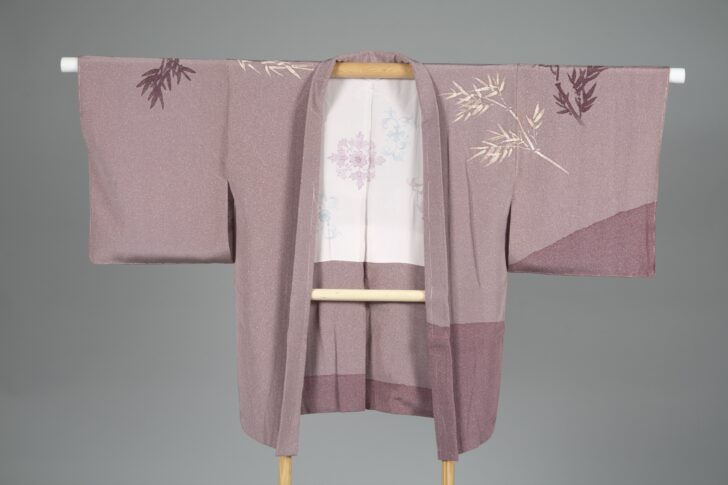Haori
Japanese

Description
Subject Matter:
The light and dark lavender designs were rendered using rouketsu (wax-resist) and tegaki (hand painted) yuzen dyeing technique.
Rouketsu is hand-painted wax-resist dyeing technique, also known as batique.Yuzen is a stretch-resist dyeing technique invented by Miyazaki Yuzen, a famous Kyoto fan-painter during the Gentoku era (1688-1704). Yuzen has two dyeing styles: “Tegaki Yuzen” hand painting and “Kata Yuzen” stencil dyeing.
“Tegaki Yuzen” is the more traditional technique. Its hand-painting skills create beautiful and elaborate designs. “Tegaki Yuzen” is named differently according to the place in which it was produced: Kyo Yuzen (Kyoto), Kaga Yuzen (Ishikawa) and Tokyo Yuzen (Tokyo). They are the three major Yuzen in Japan. Among these, Kyo Yuzen is considered the most gorgeous and elegant.
The Haori is a traditional Japanese hip or thigh-length jacket with elongated sleeves that is worn over the kimono. The Haori typically includes an interior lining with a design that is otherwise hidden from view when worn.The haori was originally part of a man’s formal attire, but in the nineteenth century, female entertainers in Edo (modern Tokyo) adopted it as a cloak for outdoor wear in mild weather. By the end of the century, married women of the upper class adopted black crepe silk haori with family crests for formal, public occasions. For much of the twentieth century, the haori has been the standard outerwear for a woman who dresses in a kimono outside the home. This haori contains one kamon (family crest); The number of kamon (family crests) determines the formality of the dress. Garments with itsutsu-mon (five family crests) are the most formal. Garments with mitsumon (three family crests) and hitotsumon (one family crest) are semi-formal.
Physical Description:
lavender silk haori with dyed white and violet bamboo leaves with gold embroidery on the left front sleeve, back right sleeve, with one family crest (kamon) on the backside with a white silk inner lining with Karahana (stylized Chinese flower) motifs. The left side and left sleeve purposely contain darker lavender to emphasize asymmetry.
Usage Rights:
If you are interested in using an image for a publication, please visit https://umma.umich.edu/request-image/ for more information and to fill out the online Image Rights and Reproductions Request Form.